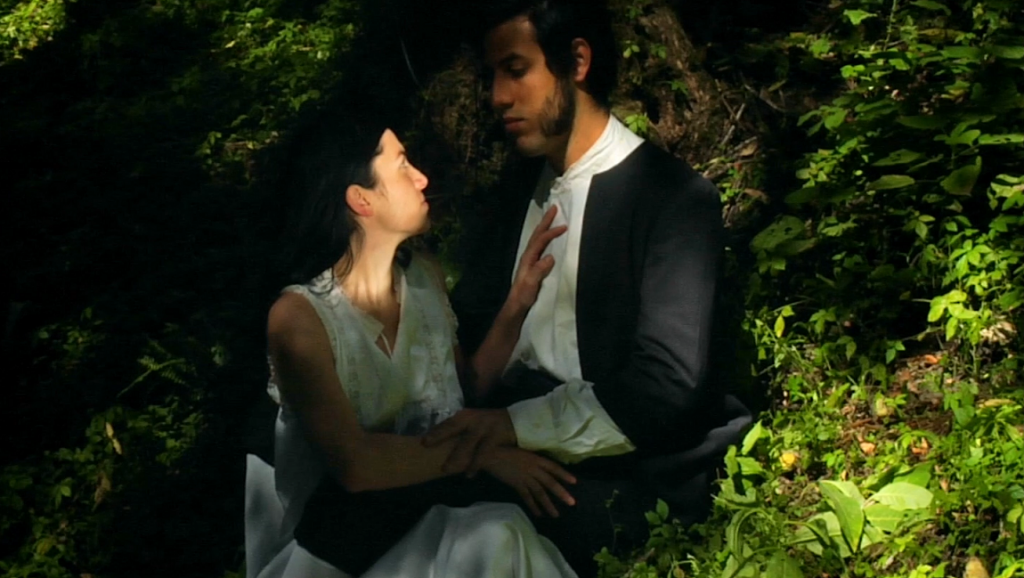Pablo Escoto’s All the Light We Can See comes with a bibliography in its end credits, a kind of road map to its poetically cryptic approach to narrative. An experimental film in the truest sense, it’s simultaneously epic and intimate, like a community theater production writ large. With what amounts to a couple of pre-existing locations, a few costumes, and a horse, Escoto manages to conjure an entire universe via a series of elliptical, sometimes abstract vignettes. It resembles a magic trick of sorts, a jumbled confluence of various influences both cinematic — Ruiz, de Oliveira, Rivette, and Straub/Huillet come immediately to mind — and literary — Frederico García Lorca’s Blood Wedding, as well as Roberto Bolano, Hannah Ardent, Efraín Huerta, Gerardo Arana and his posthumously published Meth Z, and revolutionary texts from the Zapatistas, are all among the bibliographical entries. The film is neither beholden to nor an adaptation of any of these precursors; indeed, part of the film’s strange, idiosyncratic beauty is how personal it feels. Instead, then, they function like suggested entry points and intellectual building blocks; another suggestive avenue comes from critic Ela Bittencourt, who describes the film as “like being lost in a Shakespearean forest when protagonists are both in character and somehow our contemporaries, as manifestations… slipping in and out of mythic roles.”
Serving as a prologue to the film proper, a narrator (actually Escoto’s own voice) relates the mythological tale of two lovers, Popocatépetl, a young peasant, and Ixtaccihuatl, a beautiful princess. Popocatépetl goes off to war to become a noble and become worthy of Ixtaccihuatl’s royal status. Time passes, and believing he has died in battle, Ixtaccihuatl commits suicide. When he finds her lifeless body, Popocatépetl begs the gods to keep them together forever, and the two are transformed into volcanoes — she dormant, he active. The valley between these two peaks becomes Escoto’s playground, as he follows separate plots unfolding under the auspices of these symbolic monuments. Rosario (Margarita Chavarria) mourns the death of her older lover, a General, and sits guard by his gravesite. Meanwhile, Maria (María Evoli) flees her wedding to the malevolent El Bandido (Lazaro Gabino Rodriguez) with her true love, El Toro (Inigo Malvido). The Bandit pursues them, although the leisurely pace by which the couple traverse the countryside suggests an Edenic revelry more than a chase. These stories eventually intersect, and the film moves from day into night, taking on a dream-like ambiance in the process. Working with cinematographer Jesus Nunez, Escoto utilizes a variety of digital textures to defamiliarize the landscape, shifting from the pictorially beautiful to the starkly monochromatic. By the time night falls, scenes are illuminated by only a single harsh spotlight, creating a kind of pixelated chiaroscuro as characters are seemingly carved out of the darkness.
Toward the end of the film, Escoto’s narrator returns to detail the Zapatista uprising in 1994, where rebels descended from the mountains into the cities and released a manifesto demanding basic human rights. The same year, in a bit of cosmic synchronicity, Popocatépetl erupted after 70 years of dormancy. Meanwhile, NAFTA was also signed in to law in January 1994, an unrelated act that nonetheless gains some resonance in hindsight. After all, NAFTA would lead to an explosion of low-paying factory jobs in Juarez, Mexico in the years to come, which would in turn eventually become the site of hundreds of unsolved murders. This horrific bit of history is, of course, the basis for Bolano’s magnum opus 2666, itself a model for the kind of diffuse narrative gamesmanship Escoto is attempting here. Following this kind of vaguely conspiratorial interconnectedness can elucidate as much as it obfuscates, and Escoto provocatively juxtaposes all these disparate threads into a wide-ranging survey of our current era. By causally linking mythology, 19th- and 20th-century literature, radical politics, and a very particular strand of modernist art cinema, Escoto collapses these historical modes into a new form, an elegy for the past that still looks forward toward the future. The gods won’t save us, so we must save ourselves.
Published as part of New Directors/New Films 2021 — Dispatch 3.


Comments are closed.